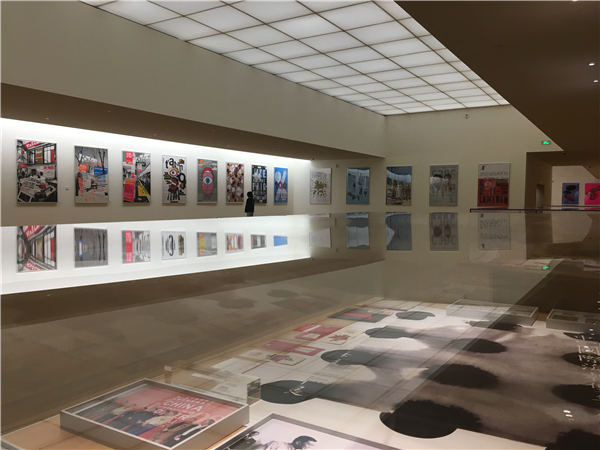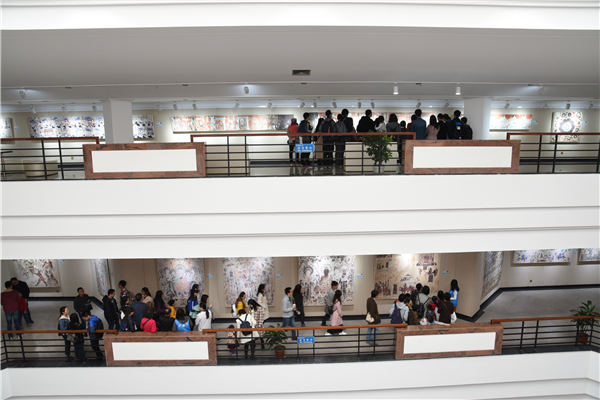



More than 30 higher education institutions have banded together in a bid to improve and develop the cultural repositories of the nation's universities.
Shortly after the China Design Museum was inaugurated on the Xiangshan Campus of the China Academy of Art in Hangzhou, the capital of East China's Zhejiang province, locals and fans of fine art from further afield have all had to endure long queues to enter the institution.
The scenario is not common for a museum of a Chinese college, and it has received more than 200,000 visits since it opened its doors in April.
Described by Xu Jiang, president of the CAA, as "China's first museum with a systematic collection of original Western modern design work", the museum houses more than 7,000 exhibits reflecting modern Western design-including 350 original design pieces from the Bauhaus, the world-famous German design school which was active from 1919 to 1933-which were bought by Hangzhou city government in 2011.
It is also home to myriad samples of Western fashion design and numerous film posters.
However, it seems that, only a few months later, the popularity of this extraordinary museum has abated somewhat: Most of its galleries look empty, except for some scattered visitors-mostly art students and teachers.
It's not just the chilly December weather that's to blame, and it has prompted the question from many Chinese universities: How do they make their museums more appealing to the public over the long term?
Earlier this month, delegates from more than 30 higher education institutions from all over the country gathered at the CAA to attend the annual conference for development of university museums in China.
According to Luo Jing, a department director in charge of museum development under the National Cultural Heritage Administration, there are over 400 museums in China's universities which have their own museum, and each one, on average, attracts less than 50,000 visits a year.
In comparison, China has about 5,100 registered non-university based museums nationwide, that, in 2017, held over 20,000 exhibitions which attracted over 900 million visits according to the administration's statistics.
"There's huge potential to make full use of the resources in the university museums," says Luo. "However, much more work needs to be done."
Luo cites a survey which reported the embarrassing statistic that about 70 percent of the country's university museums hold just three exhibitions, or fewer, a year.
"I've seen an extreme case where one museum didn't change its exhibition for 15 years," says Luo.
"A college museum should serve as a place to display its most recent research achievements," Luo says. "It should be mixed into the general development of the university."

Comprehensive institutions
Some universities have set good examples.
The Sichuan University Museum in Chengdu, the capital of Southwest China's Sichuan province, can be dated back to 1914, when Daniel Sheets Dye, an American professor working at the university, launched the institution. The museum's new building was opened in 2005 and designed to house a wide range of exhibits on archaeology, ethnology, fine arts, among other fields. More than 2,000 exhibits are regularly on display.
It is, so far, the only comprehensive museum in a Chinese university which is open to the public all the year around, according to Zhang Ping, a director in charge of scientific research in the museum.
"Lectures for the public are frequently hosted at the venue and more academic research can be done using this platform," Zhang says. "That's the way to build our connection with local communities."
More universities sharing similarly comprehensive collections are on the way to fulfilling their social responsibility.
In Nanjing University, Shi Mei, director of Nanjing University Museum, eagerly awaits the opening of a new museum building in 2022. The new site will enable the display of the university's large hoard of cultural relics, ancient books, specimens from the natural sciences, and more.
As one of the best universities in East China, Nanjing University has had a museum since 2015, but has already outgrown the current building, which cannot support big exhibitions.
When a set of precious ancient stone rubbings were displayed in 2017, Shi could only permit the exhibition to run for 10 days for safety reasons.
"People have a huge interest in such rarely-seen treasures," she observes. "But we're not capable of receiving so many people."
The university also has among its collection Tiao'er Tu ("a leisure official picks his ear"), a famous 10th-century scroll painting. However, this national treasure has not been exhibited since 1949 and, as such, few students at the university are aware of its existence.
When a museum in Shanghai wanted to borrow it for a temporary exhibition, Shi refused, fearing it would not be returned because of the better exhibition and storage conditions there.
"Development of the museums will save many collections in universities from the same fate of being covered in dust and getting forgotten," Shi says.

Diverse choices
With that said, the practice of having a big institution may not be suitable for all campuses.
"A university museum doesn't necessarily have to be a comprehensive one," Xu from the CAA says. "Different schools within one college can focus on their strengths, providing the public with something unique and complementary to the public museums off campus."
In 2015, the CAA opened its Folk Crafts Museum to specifically display artifacts and artworks pertaining to traditional Chinese craftsmanship. Along with the China Design Museum, the whole complex is looking to do just that.
Perhaps, a good example is the Arthur M. Sackler Museum of Art and Archaeology at Peking University.
Opened in 1993 with sponsorship from the eponymous American philanthropist, over the past quarter of a century, it has grown into one of the country's most important archaeology museums, thanks in no small part to the strong academic research of the university's archaeology department.
The museum-one of three in Peking University-attracted over 100,000 visits in 2017.
Three museums may seem small, though, considering that PKU is hailed, together with Tsinghua University, as one of the top two universities on the Chinese mainland. By comparison, the museum complex at Harvard University includes as many as 17 institutions.
One major positive is that everything has taken off in recent years, since the National Cultural Heritage Administration and Ministry of Education co-released national guidance for the development of university museums in 2011.
Tsinghua University Art Museum, which is based at the university's academy of arts and design, also opened its doors in 2016 and has offered numerous top-tier fine art and cultural relic exhibitions since.
A new alliance
Many challenges remain for the university museum operators to achieve their goals.
Lack of personnel is a problem, for example, even in established institutions.
Just five full-time employees work at the Sichuan University Museum. And in the Arthur M. Sackler Museum of Art and Archaeology, there are merely four. Fudan University Museum in Shanghai only has two employees, despite Fudan's high status in the Chinese higher education circle.
Speaking about the problem, Cao Hong, deputy director of the Arthur M. Sackler Museum of Art and Archaeology, says: "We organize seven to eight exhibitions a year. It has been too exhausting for us. An exhibition needs a lot of academic support."
That also partially explains why many exhibitions hosted by university museums run only for short time frames.
In many cases, college students are recruited as volunteers to design the exhibitions.
Funding is another major hurdle. Unlike publicly-owned museums off campus, which enjoy the financial support of the government, university museums don't benefit from such subsidies.
According to Zhang from the Sichuan University Museum, only 800,000 yuan ($116,000) is allocated to the museum every year by the university to maintain operations. In Nanjing University's case, the financial burden of building a new museum is mainly being borne by a 100 million yuan donation made by a philanthropic entrepreneur.
"The daily operation of the museum cannot be treated as academic research achievements in today's evaluation system," adds Xu. "That is a setback if we want to encourage more impetus among teachers and students to contribute to the museums."
Consequently, the Alliance of University Art Museums of China was initiated during the conference in Hangzhou to combine the efforts of about 30 universities for better development of the whole industry.
The alliance will enable the universities to share resources and promote academic exchanges. The committee of the alliance will have annual meeting, and a relevant academic journal is to be launched. More cooperative exhibitions are also planned through the new platform.
According to Hang Jian, deputy president of the CAA and main convener of the alliance, the organization will not only include universities on the Chinese mainland, but it is also open to counterparts from Hong Kong, Macao and Taiwan.
"Infrastructure of university museums has been greatly improved in the past few years," Luo from the National Cultural Heritage Administration says. "However, management and expertise has to catch up. A greater number of professional groups such as this are also needed."
Luo also says that several ministry-level government departments will soon draft a new plan to create a better environment for the museums through policies and fiscal support.
For example, he suggests that some cultural relics, which have been repatriated from other countries or transferred from other institutions, can be allocated to university museums based on their academic strengths.
Artifacts donated by alumni from overseas can also enjoy tax breaks, and the special funds of the State Council, which are used to support the protection of cultural relics, will probably include university museums in the near future.
If you have any problems with this article, please contact us at app@chinadaily.com.cn and we'll immediately get back to you.